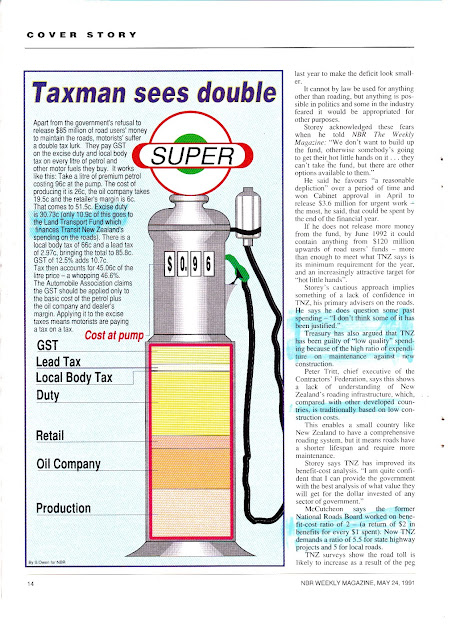This article from the National Business Review (NBR) Weekly Magazine in 1991 describes road funding at the time, and how the then Transport Minister Rob Storey had been unsuccessful in obtaining an increase in funding from the previous year. The article focuses on how much revenue collected from road users is not spent on roads and the effects of tight levels of road spending at the time.
At the time, funding was extremely tight for roads, with the previous year's budget for Transit New Zealand cut by 12%, and not being increased. There was insufficient budget for all planned maintenance let alone significant capital spending, and the article was noting how many major capital projects looked unlikely to proceed in the foreseeable future.
Transit New Zealand was only approved the same level of funding for 1991/92 as it received in 1990/91, but it sought a 13% increase as being enough as the "minimum necessary" to maintain the system. In 1990/91 it had already had a cut in funding of 12% on the previous year, which had effectively ended new capital spending. Spending increases were refused as Ministers figured that Transit New Zealand asked for more than it needed, and it was believed it ought to become more efficient.
Although efficiencies were achieved, this was later noted as a mistake, which cost significantly more in additional capital spending due to the damage caused from deferred maintenance.
Key points in the article are:
- Around half of revenue collected from road users is general revenue, and only a third goes on road spending (the remainder goes on public transport subsidies).
- 10% of the state highway system is in a "dangerous" state.
- One-fifth of the distance of arterial local roads urgently needs resealing because of low skid resistance.
- More funds would be released to Transit New Zealand if it proved it spent its approved budget well.
- Transit New Zealand claimed the effect would be to snowball road deterioration that would cost more to repair (which was proven correct).
- Excise duty at the time was $0.3097/l $0.109 of which went into the Land Transport Fund.
- Transit New Zealand was funding projects with a BCR of 5.5 and above (for state highways) and 5 (for local roads) until 1991.
- There was a $75m backlog of spending on bridge renewals.
- Nearly civil works contractors went into receivership in the previous year.
- Transit NZ General Manager says the roads won't fall to bits, but improvements won't happen.
- Rough road surfaces are estimated to increase fuel consumption by 20% and vehicle repair costs by 40%
- A single 200mm diameter pothole costs the economy around $6,000 p.a.
- Minister Storey wanted a guaranteed minimum level of funding each year for Transit New Zealand.
- Minister Storey was in favour of tolls to support new construction and to allow private companies to set up their own toll roads.





No comments:
Post a Comment
Comments are gratefully received, but any comments including abuse or spam will be deleted